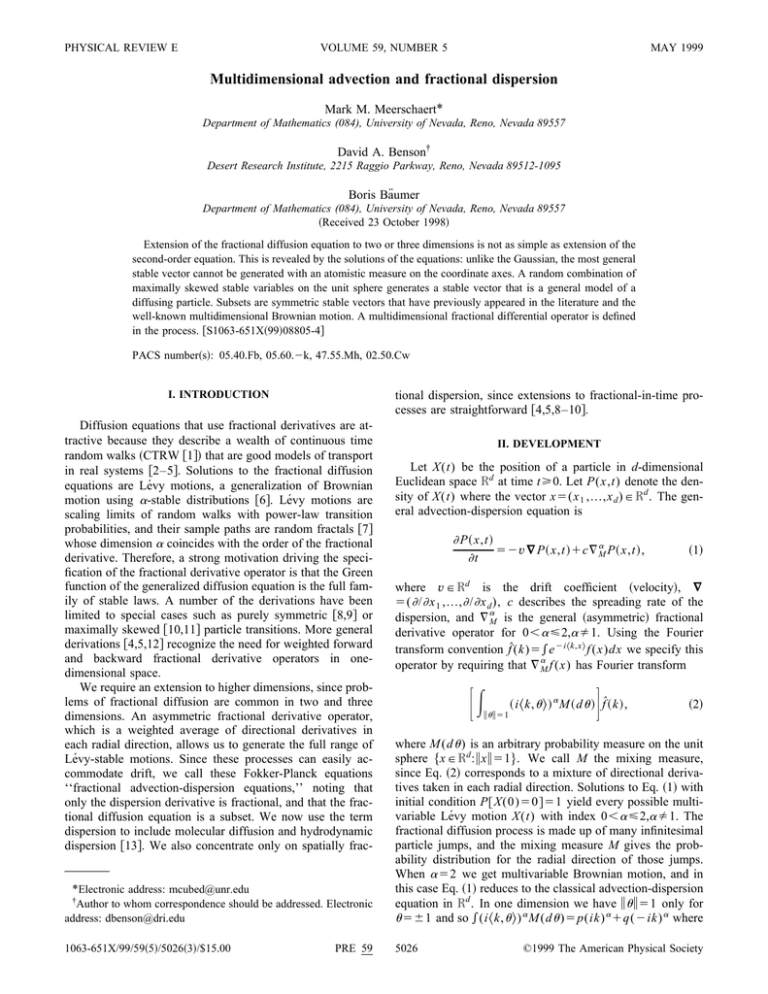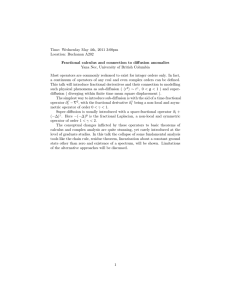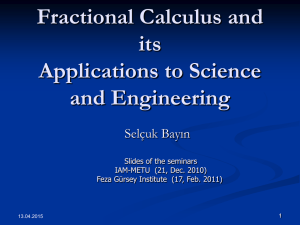Multidimensional advection and fractional dispersion
advertisement

PHYSICAL REVIEW E VOLUME 59, NUMBER 5 MAY 1999 Multidimensional advection and fractional dispersion Mark M. Meerschaert* Department of Mathematics (084), University of Nevada, Reno, Nevada 89557 David A. Benson† Desert Research Institute, 2215 Raggio Parkway, Reno, Nevada 89512-1095 Boris Bäumer Department of Mathematics (084), University of Nevada, Reno, Nevada 89557 ~Received 23 October 1998! Extension of the fractional diffusion equation to two or three dimensions is not as simple as extension of the second-order equation. This is revealed by the solutions of the equations: unlike the Gaussian, the most general stable vector cannot be generated with an atomistic measure on the coordinate axes. A random combination of maximally skewed stable variables on the unit sphere generates a stable vector that is a general model of a diffusing particle. Subsets are symmetric stable vectors that have previously appeared in the literature and the well-known multidimensional Brownian motion. A multidimensional fractional differential operator is defined in the process. @S1063-651X~99!08805-4# PACS number~s!: 05.40.Fb, 05.60.2k, 47.55.Mh, 02.50.Cw I. INTRODUCTION tional dispersion, since extensions to fractional-in-time processes are straightforward @4,5,8–10#. Diffusion equations that use fractional derivatives are attractive because they describe a wealth of continuous time random walks ~CTRW @1#! that are good models of transport in real systems @2–5#. Solutions to the fractional diffusion equations are Lévy motions, a generalization of Brownian motion using a-stable distributions @6#. Lévy motions are scaling limits of random walks with power-law transition probabilities, and their sample paths are random fractals @7# whose dimension a coincides with the order of the fractional derivative. Therefore, a strong motivation driving the specification of the fractional derivative operator is that the Green function of the generalized diffusion equation is the full family of stable laws. A number of the derivations have been limited to special cases such as purely symmetric @8,9# or maximally skewed @10,11# particle transitions. More general derivations @4,5,12# recognize the need for weighted forward and backward fractional derivative operators in onedimensional space. We require an extension to higher dimensions, since problems of fractional diffusion are common in two and three dimensions. An asymmetric fractional derivative operator, which is a weighted average of directional derivatives in each radial direction, allows us to generate the full range of Lévy-stable motions. Since these processes can easily accommodate drift, we call these Fokker-Planck equations ‘‘fractional advection-dispersion equations,’’ noting that only the dispersion derivative is fractional, and that the fractional diffusion equation is a subset. We now use the term dispersion to include molecular diffusion and hydrodynamic dispersion @13#. We also concentrate only on spatially frac- II. DEVELOPMENT Let X(t) be the position of a particle in d-dimensional Euclidean space Rd at time t>0. Let P(x,t) denote the density of X(t) where the vector x5(x 1 ,...,x d )PRd . The general advection-dispersion equation is ] P ~ x,t ! 52 v “ P ~ x,t ! 1c¹ aM P ~ x,t ! , ]t ~1! where v PRd is the drift coefficient ~velocity!, “ 5( ] / ] x 1 ,..., ] / ] x d ), c describes the spreading rate of the dispersion, and ¹ aM is the general ~asymmetric! fractional derivative operator for 0, a <2,a Þ1. Using the Fourier transform convention f̂ (k)5 * e 2i ^ k,x & f (x)dx we specify this operator by requiring that ¹ aM f (x) has Fourier transform FE i u i 51 G ~ i ^ k, u & ! a M ~ d u ! f̂ ~ k ! , ~2! † Author to whom correspondence should be addressed. Electronic address: dbenson@dri.edu where M (d u ) is an arbitrary probability measure on the unit sphere $ xPRd : i x i 51 % . We call M the mixing measure, since Eq. ~2! corresponds to a mixture of directional derivatives taken in each radial direction. Solutions to Eq. ~1! with initial condition P @ X(0)50 # 51 yield every possible multivariable Lévy motion X(t) with index 0, a <2,a Þ1. The fractional diffusion process is made up of many infinitesimal particle jumps, and the mixing measure M gives the probability distribution for the radial direction of those jumps. When a 52 we get multivariable Brownian motion, and in this case Eq. ~1! reduces to the classical advection-dispersion equation in Rd . In one dimension we have i u i 51 only for u 561 and so * (i ^ k, u & ) a M (d u )5p(ik) a 1q(2ik) a where 1063-651X/99/59~5!/5026~3!/$15.00 5026 *Electronic address: mcubed@unr.edu PRE 59 ©1999 The American Physical Society PRE 59 MULTIDIMENSIONAL ADVECTION AND FRACTIONAL . . . p1q51 and then Eq. ~1! reduces to the general onedimensional fractional advection-dispersion equation @4,5,12#. Take Fourier transforms of Eq. ~1! to obtain 1c FE a i u i 51 G ~ i ^ k, u & ! M ~ d u ! P̂ ~ k,t ! , ~3! F E i u i 51 G 5 ~ i ^ k, u & ! a M ~ d u ! . ~4! Using (iu) a 5(e i p /2u) a 5 u u u a cos(pa/2) $ 11i sgn(u)tan(pa /2) % the right hand side above becomes F exp 2i ^ k, v t & 1ct H E i u i 51 u ^ k, u & u a cos 3 11i sgn~ ^ k, u & ! tan S DJ pa 2 S D pa 2 G M~du! , ~5! E dn 1 G ~ n2 a ! ds n ` 0 r n2 a 21 g ~ s2r ! dr, 1 G~ 2a ! E ` 0 1 G~ 2a ! E E i u i 51 ` 0 0 r 2 a 21 f ~ x2r u ! dr m ~ u ! d u i u i 51 ` 0 r 2 a 2d m ~ u ! 1 dc d G ~ 2 a ! E yPRd i y i 2 a 2d m S D y f ~ x2y ! dy, iyi E S( D d i u i 51 j51 k ju j 2 M ~ d u ! 5 ~ ik ! A ~ ik ! T , r 2 a 21 f ~ x2r u ! dr M ~ d u ! ~6! ~7! where the matrix A5(a i j ) with a i j 5 * u i u j M (d u ). Then Eq. ~1! reduces to the classical advection-dispersion equation with ¹ aM 5“A¹ T 5 ( i, j a i j ] 2 / ] x i ] x j and P̂ ~ k,t ! 5exp@ 2i ^ k, v t & 2ctkAk T # , which is the Fourier transform of a Gaussian with mean v t and covariance matrix 2ctA, so we recover multivariate Brownian motion with drift. When M (d u )5M (2d u ) the integral in Eq. ~2! reduces to 1 2 E i u i 51 ~ i ^ k, u & ! a 1 ~ i ^ k,2 u & ! a M ~ d u ! S DE pa 2 i u i 51 u ^ k, u & u a M ~ d u ! ~8! using (iu) a 1(2iu) a 52 u u u a cos(pa/2). Furthermore, if M (d u ) is uniform then X(t) is symmetric stable, and by Eq. ~4! its density P(x,t) has Fourier transform F P̂ ~ k,t ! 5exp 2i ^ k, v t & 1ca d t i k i a cos r 2 a 21 g ~ s2r ! dr, a convolution of generalized functions @14#, p. 154. The fractional order directional derivative D ua f (x) is defined by a g(s) evaluated at s50, where g(s)5 f (x1s u ). Taking a D1 mixture over the unit sphere i u i 51 we get the convolution formula ¹ aM f ~ x ! 5 i u i 51 1 dc d G ~ 2 ! 5cos where n511 @ a # is the smallest integer greater than a, and it is easy to check that this convolution integral has Fourier transform (iu) a ĝ(u) @5,14#. Take the derivative inside the integral and integrate by parts to obtain a D1 g~ s !5 ` a ‘‘hypersingular integral with homogeneous characteristic,’’ @14#, p. 518. When m( u ) is a constant function this integral reduces to the well-known convolution equation for the Riesz fractional derivative ¹ a f (x), @14#, p. 483. We can also write Eq. ~6! in the compact form ¹ aM f (x)5 * yÞ0 f (x 2y) f (d u ) where f (dy)5r 2 a 21 drM (d u )/G(2 a ) in polar coordinates. When a 52 the mixing measure M determines the covariance matrix. In this case the integral in Eq. ~2! reduces to 2 which is the Fourier transform of an arbitrary multivariable stable distribution with index a Þ1, compare @6#, p. 65. Thus the Green function solution to Eq. ~1! yields the entire class of multivariable Lévy motions for a Þ1. The asymmetric fractional derivative operator ¹ aM in Eq. ~1! is a mixture of fractional directional derivatives. The directional derivative D u f (x)5 ^ u ,“ f (x) & 5 ( j u j ] f (x)/ ] x j 5dg/ds at s50 where g(s)5 f (x1s u ). Its Fourier transform is ( j u j ik j f̂ (k)5i ^ k, u & f̂ (k) since ik j f̂ (k) is the Fourier transform of ] f (x)/ ] x j . We can define fractional derivatives using convolutions of generalized functions in real space, or products in Fourier space @14#. The scalar fractional derivative is a D1 g~ s !5 5 E E E E a 1 G~ 2a ! 3 f ~ x2r u ! dc d r d21 dr d u so that for our initial condition P̂(k,0)[1 we obtain P̂ ~ k,t ! 5exp 2i ^ k, v t & 1ct whose Fourier transform is given by Eq. ~2!. If M (d u ) 5m( u )d u and the constant c d is the volume of the unit sphere in Rd then a change of variables yields ¹ aM f ~ x ! 5 d P̂ ~ k,t ! 52i ^ k, v & P̂ ~ k,t ! dt 5027 S DG pa 2 , where the constant a d 5 *u u 1 u a M (d u ) depends only on a and the dimension d of the space. III. DISCUSSION Every stable random vector is of the form b1UR where U is a random unit vector and R is a stable random variable which is maximally skewed and independent of U. The solution X(t) to Eq. ~1! is of this form with mean b5 v t and P @ UPA # 5M (A). Since X(t) is a Markov process with sta- 5028 MEERSCHAERT, BENSON, AND BÄUMER PRE 59 tionary independent increments, the probability distribution M governs the direction of infinitesimal jumps. Numerical simulation of the fractional dispersion process X(t) can be accomplished by adding small jumps X(t1Dt)2X(t) of stable random vectors. Each jump is of the form v Dt1UR where the jump direction U has probability distribution M on the unit sphere. In terms of the standard parametrization for stable random variables @6#, the jump size R is centered a stable with skewness 11 and scale s satisfying s a 52cDt cos(pa/2), so R can be simulated using the formula of Kanter @15#. For a ,2 the fractional dispersion X(t) is symmetric if and only if jumps in any direction are equally likely, while X(t)5„x 1 (t),...,x d (t)… has independent components x j (t) if and only if jumps are restricted to the coordinate axes, @6#, p. 68. For a 52 both randomly directed and orthogonal jumps generate the same Brownian motion. This property is unique to the multivariate normal, @16#, p. 258. Different mixing measures M yield different processes when a ,2, while for a 52 we saw in Eq. ~7! that the moments of M suffice to parametrize the dispersion process. Lévy motions are scaling limits of random walks. Suppose Z,Z 1 ,Z 2 ,Z 3 ,...,Z n are independent and identically distributed random vectors in Rd . If the rescaled random walk a(l)(Z 1 1¯1Z @ lt # )⇒L(t) as l→` then L(t) is a Lévy motion @17#. If E i Z i 2 ,` then a(l)5l 21/2 and L(t) is a Brownian motion. If we have P @ i Z i .r # ;Cr 2 a and P @ i Z i .r,Z/ i Z i PA # ; P @ i Z i .r # M (A) as r→`, then we get convergence with a (l)5l 21/a and L(t) is a Lévy process with index a ,2 and mixing measure M @17#. Hence the fractional dispersion process X(t)5 v t1L(t) described by Eq. ~1! gives a very robust model for particle motions. Only some generic tail properties of the jumps must be specified, and every possible limiting process is obtained. The formula ~5! for the Fourier transform of X(t) is computed using the Lévy measure f t (dy) 5ct a r 2 a 21 drM (d u )/G(2 a ), see @6#, p. 66. When a ,2 the general convergence criterion for rescaled random walks is l P @ a(l)ZPA # → f 1 (A) as l→` @18#. The same Lévy measure f 1 appears in the formula for the generator of the convolution semigroup $ P(x,t):t>0 % @19#. Point process theory says that X(t) is the limit of compound Poisson random vectors, where f t (dy) gives the intensity of jumps of size y @20#. Finally, convolution with a Lévy measure is the simplest way to describe the full range of fractional derivatives. In our development, we obtained the formula c¹ aM f (x)5 * yÞ0 f (x2y) f 1 (dy). This surprising connection between Lévy measures and fractional derivatives ~or Riesz potentials! is new even in R1 . @1# H. Scher and M. Lax, Phys. Rev. B 7, 4491 ~1973!. @2# H. Scher and M. Lax, Phys. Rev. B 7, 4502 ~1973!. @3# E. Weeks et al., in Lévy Flights and Related Topics in Physics, edited by M. Shlesinger, G. Zaslavsky, and U. Frisch ~Springer-Verlag, New York, 1995!, p. 51. @4# D. Benson, Ph.D. thesis, University of Nevada, Reno, 1998 ~unpublished!. @5# D. Benson, S. Wheatcraft, and M. Meerschaert ~unpublished!. @6# G. Samorodnitsky and M. Taqqu, Stable Non-Gaussian Random Processes: Stochastic Models with Infinite Variance ~Chapman and Hall, London, 1994!. @7# S. Taylor, Math. Proc. Camb. Philos. Soc. 100, 383 ~1986!. @8# A. Compte, Phys. Rev. E 53, 4191 ~1996!. @9# R. Metzler, J. Klafter, and I. Sokolov, Phys. Rev. E 58, 1621 ~1998!. @10# G. M. Zaslavsky, Physica D 76, 110 ~1994!. @11# A. Compte, Phys. Rev. E 55, 6821 ~1997!. @12# A. S. Chaves, Phys. Lett. A 239, 13 ~1998!; A. I. Saichev and G. M. Zaslavsky, Chaos 7, 753 ~1997!. @13# J. Bear, Dynamics of Fluids in Porous Media ~Dover, New York, 1972!. @14# S. Samko, A. Kilbas, and O. Marichev, Fractional Integrals and Derivatives: Theory and Applications ~Gordon and Breach, London, 1993!. @15# M. Kanter, Ann. Prob. 3, 697 ~1975!. @16# S. Ross, A First Course in Probability, 5th ed. ~Prentice Hall, New York, 1998!. @17# E. Rvačeva, in Selected Translations in Mathematical Statistics and Probability ~American Mathematical Society, Providence, 1962!, Vol. 2, p. 183. @18# M. Meerschaert, J. Multivariate Anal. 19, 342 ~1986!. @19# W. Feller, An Introduction to Probability Theory and Its Applications, 2nd ed. ~Wiley, New York, 1971!, Vol. II. @20# S. Resnick, Extreme Values, Regular Variation, and Point Processes ~Springer-Verlag, New York, 1987!. @21# A. Janicki and A. Weron, Simulation and Chaotic Behavior of a Stable Stochastic Processes ~Dekker, New York, 1994!. @22# S. Garabedian et al., Water Resour. Res. 27, 911 ~1991!. @23# E. Adams and L. Gelhar, Water Resour. Res. 28, 3293 ~1992!. IV. SUMMARY The connection between certain stochastic processes and their governing partial differential equation is well known. In particular, Brownian motion implies a second-order diffusion equation @19#. We have shown a similar implication between the superset of diffusive motions—the stable Lévy motions—and the fractional advection-dispersion equation. The implication is shown by the n-dimensional fractional derivative defined as a convolution with a Lévy measure. The motions described by the fractional equation derived herein are characterized by occasional large jumps @6,21#. The particle paths are fractals whose dimension corresponds to the order of the fractional derivative @7#. The motions can be symmetric or have any degree of skewness in several dimensions. One should expect skewed and fractional molecular diffusion in the midst of high chemical gradients and concentrations @4#. Dissolved solutes moving through porous aquifer material may exhibit nearly symmetric @22# to highly skewed @23# dispersion. ACKNOWLEDGMENT D.A.B. received financial support from the U.S. Department of Energy, Basic Energy Sciences under Grant No. DE-FG03-98ER14885.




